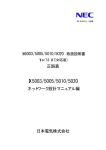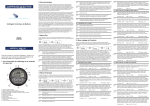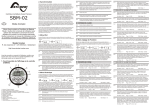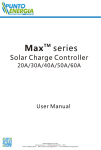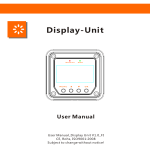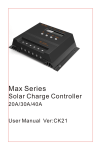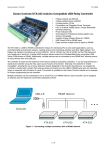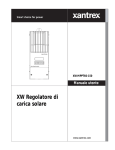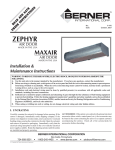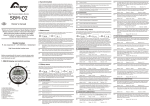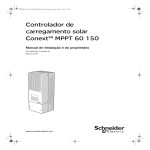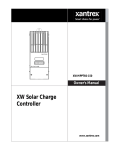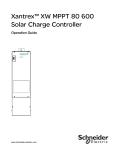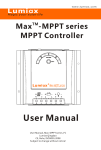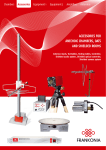Download Max48 series Solar Controller User Manual
Transcript
TM Max -48 series Solar Charge Controller 10A/20A/30A User Manual User Manual_Max48 series_DJ23 CE, Rohs, ISO9001:2008 Subject to change without notice! Contents 1 Description of function P1 2 Safety Instructions and Waiver of Liability P1 2.1 Safety P1 2.2 Liability Exclusion P1 3 Dimensions P1 4 Optional P1 4.1 Remote display unit P1 4.2 Remote temperature sensor P1 5 Installation P2 5.1 Mounting location requirements P2 5.2 Fastening the solar charge controller P2 5.3 Preparation of wiring P2 5.4 Connection P2 5.5 Grounding P3 6 Indication of Status P4 7 Operating the solar charge controller P5 7.1 Factory Pre-Set configurations P5 7.2 Main Menu P5 7.3 Menu Conf (System module settings) P6 7.4 Menu Prog (System parameter settings) P6 7.5 Menu Load (Load mode settings) P8 7.6 Menu Logg (Inquiry of internal data logger) P9 7.7 Example of configuration P 10 7.7.1 Battery type P 10 7.7.2 Reset to Factory Pre-Set Configuration P 10 8 Safety Measures P 11 8.1 Electronic Short Circuit Safety P 11 8.2 Hardware Safety P 11 8.3 Safety Features P 11 9 Malfunctions and Errors P 12 10 Technical Data P 13 10.1 Performance Data P 13 10.2 Controlling Data(25℃) P 13 10.3 Parameter settings P 13 Dear Clients, TM Thanks for selecting the Max -48 series solar controller. Please take the time to read this user manual, this will help you to make full use of many advantages the controller can provide your solar system. This manual gives important recommendations for installing, program, using and so on. Read it carefully in your own interest please. 1. Description of function With your new Max48 series controller you own a state- 2.Safety instructions and waiver of liability of-the art device which was developed according to the 2.1 Safety latest available technical standards. It comes with a ①The solar charge controller may only be used number of outstanding features, such as: in PV systems in accordance with this user manual and the specifications of other modules LCD display manufacturers. No energy source other than a One year's data memory solar generator may be connected to the solar 48V system voltage External temperature sensor, make the temperature compensation more accurate charge controller. ②Batteries store a large amount of energy, never short circuit a battery under all Perfect EMC design Many choices of battery type, working mode and protection Four stage PWM charge way: fast, boost, equalization, float Full automatic electronic protect function 3.Dimensions circumstances. We strongly recommend connecting a fuse directly to the battery to protect any short circuit at the battery wiring. ③Batteries can produce flammable gases. Avoid making sparks, using fire or any naked flame. Make sure that the battery room is ventilated. ④Avoid touching or short circuiting wires or terminals. Be aware that the voltages on special terminals or wires can be as much as twice the battery voltage. Use isolated tools, stand on dry ground, and keep your hands dry. ⑤Keep children away from batteries and the charge controller. 2.2 Liability Exclusion The manufacturer shall not be liable for damages, especially on the batter y, 4. Optional caused by use other than as intended or as mentioned in this manual or if the 4.1 Remote display unit Remote display unit can display system information, recommendations of the batter y failure information and one year's charge and discharge manufacturer are neglected. The manufacturer shall not be liable if there data. has been ser vice or repair carried out by 4.2 Remote temperature sensor any unauthorized person, unusual use, Acquisition the ambient temperature of the battery, wrong installation, or bad system design. which can be accurate compensation charge values, standard wire length is 2 meters (can also be customized according to user needs). Page1/13 Pages 5. Installation 5.1 Mounting location requirements Do not mount the solar charge controller outdoors or in wet rooms. Do not subject the solar charge controller to direct sunshine or other sources of heat. Protect the solar charge controller from dirt and moisture. Mount upright on the wall on a non-flammable substrate. Maintain a minimum clearance of 10cm below and around the device to ensure unhindered air circulation. Mount the solar charge controller as close as possible to the batteries. 5.2 Fastening the solar charge controller Mark the position of the solar charge controller fastening holes on the wall, drill 4 holes and insert dowels, fasten the solar charge controller to the wall with the cable openings facing downwards. 5.3 Preparation of wiring Mode Max.current Max1048 10A Diamete(mm²) 10 8 Max2048 20A 16 6 Max3048 30A 16 6 AWG 5.4 Connection We strongly recommend connecting a fuse directly to the battery to protect any short circuit at the battery wiring. Solar PV modules create current whenever light strikes them. The current created varies with the light intensity, but even in the case of low levels of light, full voltage is given by the modules. So, protect the solar modules from incident light during installation. Never touch uninsulated cable ends, use only insulated tools, and make sure that the wire diameter is in accordance with the solar charge controller’s expected currents. Connections must always be made in the sequence described below (Figure 1: System wiring diagram). 1st step: Connect the battery Connect the battery connection cable with the correct polarity to the middle pair of terminals on the solar charge controller (with the battery symbol). If the system is 48V, please make sure that the battery voltage is within 40V~64V. If the polarity is correct, the LCD screen on the controller will begin to show. 2nd step: Connect the solar module Ensure that the solar module is protected from incident light. Ensure that the solar module does not exceed the maximum permissible input current. Connect the solar module connection cable to the correct pole of the left pair of terminals on the solar charge controller (with the solar module symbol). 3rd step: Connect loads Connect the load cable to the correct pole of the right pair of terminals on the solar charge controller (with the lamp symbol). To avoid any voltage on the wires, first connect the wire to the load, then to the controller. 4th step: Final work Fasten all cables with strain relief in the direct vicinity of the solar charge controller (clearance of approx.10cm). Page2/13 Pages 5.5 Grounding Be aware that the positive terminals of the controller are connected internally and therefore have the same electrical potential. If any grounding is required always do this on the positive wires. Figure 1: System wiring COM TEMP SOC BAT IN OUT OK MENU Max series Solar charge controller ③ ④ ① ② ⑤ ⑥ !Remark: If the device is used in a vehicle which has the battery negative on the chassis, loads connected to the controller must not have an electric connection to the car body, otherwise the low voltage disconnect and electronic fuse functions of the controller are short circuited. Page3/13 Pages 6.Indication of Status The two-line display indicates all present system values in short form on the top line, and the values are without units (Volt, Amp, etc) due to a lack of space. The printing above each value serves as a reminder: State of charge SOC Battery voltage BAT Charging currents IN Discharge currents OUT “SOC” means "state of charge" and indicates how much remaining capacity the battery still has. The SOC is never 100% as due to technical reasons it is easier to indicate a two-digit number. “BAT” shows the battery's actual voltage. “IN” is the sum of the charging currents flowing into the battery. “OUT” is the sum of discharge currents flowing out of the battery. The second line constantly changes its information. All values and system information are indicated alpha-numerically. The following displays can only be seen during regular operation (not while programming). OUT “I accu” is the balance of all charging and discharging currents. As long as 88% 50.8 26 I accu = 8.3A SOC 18 the charging current is higher than the discharging current, the value is 88% 50.8 26 I in = 26.4A 00 88% 50.8 15 BAT IN position, in the opposite case, it is negative. “I in” shows the charging current at the moment. When the voltage of the Temp = 00 battery is getting near the final charge voltage, the solar charge controller will regulate the “I in” in order to protect the battery from being overcharged. The charge current “I in” is lower than the module current. “Temp” displays the environment temperature of the solar charge controller. 25℃ The solar charge controller status such as "Fast charging", "Equal charging”, 88% 50.8 17 Boost charging 15 ”Boost charging”, ”Float charging” and "No Charging” indicate which stage of charging is in process. After a certain period of time of operation in the “Boost” and “Equal” charging modes, the “Float” charge mode is resumed. 88% 50.8 Load on 00 15 The content displays the current load state, “Load on” means the load has been opened, “Load off” means the load is in a closed state. Page4/13 Pages 7.Operating the solar charge controller 7.1 Factory Pre-Set configurations With the factory pre-set configurations, the solar charge controller can be used in most applications without further programming. On delivery, the controller is always set with these pre-set basic configurations that enable immediate use of most typical solar systems after installation. The solar charge controller can be reset to the factory pre-set configurations at any time with the Menu CONF. 7.2 Main Menu Set values and functions can be adjusted with the four control keys on the panel. By pressing the key under the MENU, a Main Menu appears in the display – Conf (System module settings), Prog (System parameter settings), Load (Load mode settings) and Logg (Inquiry of internal data logger). By pressing the key below the corresponding abbreviation, you can enter the corresponding menu (Figure 2: Programming Menu). After entering the corresponding menu, the following actions can be set or viewed the appropriate information: ①You can use the keys ▲▼ to select sub-menu, and press the OK button to enter the sub-menu. ②After entering the sub-menu, press ▲▼ to change the value. ③After setting, press the OK button to save the set value, and return to the previous menu level. ④Pressing the MENU key will exit the setting, bring the display back to the normal Main Menu. !Note: 1.If you did not carry out any operation within 60s after entering the setup menu, the controller will automatically exit the menu programming and the normal indication of running status appears . 2.If there are no adjustments on an activated submenu value being changed, the display indication jumps to the main menu and the adjustment in the open window is not stored or applicable. Figure 2: Programming Menu 88% 50.8 26 I accu = 8.3A OK Conf Logg OK Liquid Nominal capacity 300Ah Regulation SOC Factory adjust Press OK+MENU MENU Load Prog Battery type 18 Float charge MENU Load control 54.8V Boost charge AUTO Light on delay 58.0V Equal charge 00:00 Light off delay 59.2V D/N threshold 00:00 Night timer 1 12.0V Disconnect 00:00 Night timer 2 30% Reconnect 50% Page5/13 Pages 00:00 Day in Ah out Total KAh 100 80 in 1200 out 880 7.3 Menu Conf (System module settings) In this menu, you can configure the system modules, including battery type, battery nominal capacity, Battery type selection: Press the OK button to enter the menu, you may toggle Battery type Liquid between ▲▼ Gel to liquid electrolyte. Possibilities for programming: Liquid, Gel (Default: Liquid). Battery nominal capacity: Press the OK button to enter the menu, press arrow keys ▲ Nominal capacity 300Ah ▼for changing the nominal capacity and press OK for entering the new value. Possibilities for programming: 10Ah~9990Ah (Default: 300Ah). Note: The nominal capacity must be consistent with the actual battery capacity when the controller is installed. Low voltage protection mode (Soc or voltage control) settings: Press the OK button Regulation Soc Factory adjust Press OK+MENU to enter the menu, and switch with the keys ▲ ▼ between SOC and Voltage. Possibilities for programming: Soc, Voltage (Default: Soc). Factory pre-set: Press the OK button to enter the menu, and press the "OK + MENU" button simultaneously to reset the solar charge controller. Note: If you press “OK+MENU”, all settings and values will be reset and the execution will be confirmed by “Done”. 7.4 M enu P rog (System parameter settings) In this menu you can set the charging parameters, Day/Nigh threshold, LVD and LVR data. Press ▼ t o ent e r the menu. Note: We have tried to insure that the values are limited within ranges that do not damage the battery immediately. However, certain skills are needed as far as battery behaviour is concerned to prevent longterm damage or poor system performance. If you are unsure about any of these settings, please refer to your authorised dealer or leave the pre-set configurations as they are. Float charge 54.8V Float voltage settings: Press the OK button to enter the menu, press ▲ ▼ to change the value. Note: The float voltage serves for maintaining the charge in the battery for long periods and preventing self-discharge. This voltage should not be too high, since this may lead to permanent gassing, which damages the battery. Maximum values are stated on the battery data sheet of your battery. For most types of liquid battery, this float value is 54.8V. Possibilities for programming: 51.7~58.0V (Default: 54.8V). Boost voltage settings: Press the OK button to enter the menu, press ▲ ▼ to change Boost charge 58.0V the value. Possibilities for programming: 51.8~64.0V (Default: 58.0V). Page6/13 Pages Equal voltage settings: Press the OK button to enter the menu, press ▲ ▼ to change Equal charge 59.2V the value. Note: 1.The equalisation charging can only be adjusted for batteries with liquid electrolyte, since high equalising voltages are harmful for sealed batteries. The maximum equalising voltage value should be stated on the battery manufacturer's data sheet. 2.This window is deactivated if you have selected “Gel” with the menu CONF. 3.Battery charging voltage is passed on directly to the loads by the solar charge controller. Therefore, during equal charging, high charging voltages can be programmed that may damage some loads. Please select this equal charge voltage very carefully and compare the desired value to the battery and load (appliance) manufacturers' data sheets. Possibilities for programming: 53.0~64.0V (Default: 59.2V). Note: The fast charge voltage is fixed at 56.0V, users do not have their own set. Day/Night threshold settings: Press the OK button to enter the menu, press ▲ ▼ to D/N threshold change the value. 12.0V The controller recognizes day and night based on the solar array open circuit voltage (only functional in street-light mode). This day/night threshold can be modified according to local light conditions and the solar array used. Possibilities for programming: 12.0~30.0V(Default: 12.0V). Low voltage disconnect settings: Press the OK button to enter the menu, press ▲ ▼ Disconnect to change the value. Soc = 30% Note: 1.The difference between disconnect and reconnect threshold must be at least 20%. If you wish disconnect at higher state of charge you have to first adjust the reconnect threshold (as per below) to 20 % above the desired disconnect threshold. 2.When you configure voltage regulation, you will find in this window voltage values instead of SOC values for programming the disconnection voltage level. The solar charge controller allows the smallest difference between reconnect and disconnect is 3.2V. If you want to program a high level for disconnection you must first increase the reconnection level. Possibilities for programming by SOC: 20%~70% (Default: 30%). Possibilities for programming by voltage regulation: 44.0~50.0V (Default: 44.4V). Low voltage reconnected settings: Press the OK button to enter the menu, press ▲ ▼ Reconnect Soc = 50% to change the value. Possibilities for programming by SOC: 40%~90% (Default: 50%). Possibilities for programming: by voltage regulation: 47.2~53.2V (Default: 50.4V). Page7/13 Pages 7.5 Menu Load (Load mode settings) We can set load mode and time in this menu (Figure 3: Load mode), press the OK button to enter this menu. Load mode settings: Press the OK button to enter the menu, and press ▲ ▼ to Load control AUTO change the load mode. Possibilities for programming: “Auto”, “Standard”, “Timer” (Default: Auto). Day/Night threshold Sunset Auto: Dusk to dawn mode Light on Day/Night threshold Sunrise Dusk to dawn Light off Light off Standard: Load on mode Day/Night threshold Day/Night threshold Sunset Sunrise Timer: Double time mode Night timer1 Light on Night timer2 Light on Light off Light off Light off Figure3: Load mode The time delay of load open settings: Press the OK button to enter the menu, press ▲ ▼ to change the value. Light on delay 00:00 The solar charge controller can control night lighting automatically by evaluating the density of outside light with the help of the solar PV module array. Depending on the PV array alignment or shading, it may well be that night recognition is activated even though twilight has not yet come to an end. By the programmable time adjustment "Light on delay”, the night light switch-on may be shifted to a later time. Possibilities for programming: 00:00~02:00 (Interval 5min, Default: 00:00) Light off delay 00:00 The delay time of load close settings: Press the OK button to enter the menu, press ▲ ▼ to change the value. After setting "Light off delay" the light can remain on a period of time after dawn. Possibilities for programming: 00:00~02:00 (Internal 5min, Default: 00:00). Note: When the controller is set to "Standard", "Light on delay" and "Light off delay" have no effect on it, but when the controller is set to "Auto" and "Timer", the delay time settings work. Page8/13 Pages Night time 1 settings: Press the OK button to enter the menu, press ▲ ▼ to change the value. Night timer 1 00:00 When the “Load control" is set to "Timer", "Night timer 1” is the first part light on time when dusk coming. If set to "Auto" or "Standard", "Night timer 1" setting is invalid. Possibilities for programming: 00:00~09:00 (Interval 15min,Default: 00:00). Night time 2 setting: Press the OK button to enter the menu, press ▲ ▼ to change the value. Night timer 2 00:00 When the “Load control" is set to "Timer", "Night timer 2” is the second part light on time before dawn. If set to "Auto" or "Standard", "Night timer 2" setting is invalid. Possibilities for programming: 00:00~09:00 (Interval 15min,Default: 00:00). 7.6 Menu Logg (Inquiry of internal data logger) Press MENU button to enter the menu, you can recall stored data values from today to the last 7 days, at the same time you can view the accumulated value in and out of the system since the controller installed. From this menu window, you can read the actual daily value of amp-hours in and Day in 100 Ah out 80 out of the system. Press OK to toggle the display from today’s current running data values to the stored data values for the last 7 days. You can choose the desired day to view with the arrow key ▲▼. The values can not be changed. Note: "Day" simply stands for today and “Day 1”for the day before, “Day 2” Day 1 in Ah out 120 90 means two days ago. When a new day of logging starts, the data for each of "Day” to “Day 6” will be shifted to the previous day, i.e. the 7th day data will be replaced with the data for the 6th day, 6th day replaced by 5th day, etc. Total KAh in 1200 out 880 View the accumulated value in and out of the system since the controller installed, this data can not be changed. Note: The minimum value is 1KAh. Note: All historical data will be deleted only when the device been reset to factory settings. Page9/13 Pages 7.7 Example of configuration 7.7.1 Battery type By pressing the MENU key, you leave the online status display and go to the main menu. By pressing the key below the corresponding abbreviation: Conf (System module settings), Prog (System parameter settings) , Load (Load mode settings) and Logg (Inquiry of internal data logger), you can enter the corresponding menu. In the case of this example you have to press the first key from left (labelled▲), which is below the abbreviation Conf. This is how you get into the window for programming the Battery type (Figure 4: Change the battery type). Note: If you have pressed the wrong key by accident, press MENU to get back to the main menu and start all over again. 7.7.2 Reset to Factory Pre-Set Configuration In the previous section, it is described how to enter the window Battery type. The next window up (press ▲) is for resetting the solar charge controller to the factory pre-set configuration (Factory adjust). By pressing OK you can enter the Factory adjust window. The instruction to press the MENU key plus the OK key appears immediately. Only by pressing both of these keys simultaneously will the factory pre-set configurations be set. Then the second line shows "Done", means successfully restore the factory settings (Figure 5: Reset to Factory Pre-Set configuration). 88% 50.8 26 I accu = 8.3A OK Conf 18 8.3A OK Conf 18 MENU Load Prog Logg OK Logg OK MENU MENU Battery type Battery type OK 26 I accu = MENU Load Prog 88% 50.8 OK MENU MENU Factory adjust Battery type Liquid OK OK MENU Battery type Factory adjust Gel OK Press OK+MENU MENU OK Battery type Done MENU OK Figure 4: Change the battery type MENU Factory adjust Liquid OK MENU MENU Figure 5: Reset to Factory Pre-Set configuration Note: 1. If you want to make sure that you have programmed correctly, press only OK and move through all submenu items to check the values. Do not press the arrow keys while checking, or you will change the values. 2. If you have programmed a wrong value, you will reach the window with the undesired value again and press OK to change the value to the correct one by pressing the arrow keys▲▼. Page10/13 Pages 8 Safety Measures We urgently recommend the installation of a safety device on the battery pole in order to prevent damage from short circuits between battery and the solar charge controller. 8.1 Electronic Short Circuit Safety An electronic short circuit safety device is built into the solar charge controller and prevents both destruction of the solar charge controller and the blowing of the safety fuse in case of short circuits on the load terminals. The second line of the LCD display indicates this error as "Short circuit". After elimination of this fault, the solar charge controller automatically switches back to normal operation after about 60 seconds. 8.2 Hardware Safety In addition to the electronic fuse device mentioned above, the solar charge controller has also been protected by regular fuses which have been rated far beyond nominal currents to prevent false blowing of the fuses during surges. The safety fuses are wired in parallel. In order to prevent fuses from blowing in the case of high currents over a short period of time, a high value has been selected. Before the fuses blow, the electronic safety fuse should prevent any excessive current flow. 8.3 Safety Features Reverse polarity Short circuit Solar terminal Battery terminal Load terminal Protected *1 Protected *1 Protected *2 Protected Protected *3 Switches off immediately Over current Reverse Current Over voltage Switches off with delay Protected Max. 110V *4 Max. 80V Low voltage Over temp Switches off switches off the load if the temperature reaches the set value *1 Controller can not protect itself in a 48V system when polarity of battery or solar is reversed. *2 Controller can protect itself, but loads might be damaged. *3 Battery must be protected by fuse, or battery will be permanently damaged. *4 The solar panel voltage should not exceed this limit for a long time as voltage protection is done by a varistor. Warning: The combination of different error conditions may cause damage to the controller. Always remove the error before you continue connecting the controller. Page11/13 Pages 9 Malfunctions and Errors The solar charge controller is protected against damage by various measures. Nevertheless, always take utmost care in the proper operation of the solar charge controller. Short hints of the malfunctions are indicated with the help of the LCD display. However, errors are only properly indicated in which the system has been properly installed. If there are other malfunctions than the ones described below, please check first of all if the solar charge controller has been connected to the battery, the module and the loads correctly in the right polarity. Afterwards, check the safety fuses. Error message The cause of the malfunction Short circuit Short circuit Over current The load current is too high and the output is disconnected. Either the whole consumption exceeds the max. discharge currents or the max. Pulse currents were exceeded by using high surge appliances. Remedy Switch off all loads. Remove the fault, the controller will switch on load automatically after 1 minute. • Reduce loads or hours of operation of loads to keep the battery from being discharged Low voltage Battery has low capacity. To protect the battery, all loads powered by the solar charge controller will be disconnected. The maximum allowable temperature has Over heat been exceeded. In order to reduce further heat generation the loads are disconnected automatically. As soon as the solar charge controller has cooled down, normal operation will resume. deeply, or increase solar array to add energy to the system. • Connect all loads through the controller to avoid strong discharge of the battery. • It will restore only when the battery being recharged and the voltage reaching the reconnect voltage. • Check the ventilation at the back heat sink and clean it if necessary. • Protect the controller from direct sunshine. • Reduce warming caused by appliances near the controller. • Reduce the loads or PV modules. Over voltage In particular, the recharge process through back-up generators or chargers tied directly to the battery causes battery voltages higher than 66.0V. Disconnect external chargers, when the batter y voltage is lower than 62.0V controller automatically restored. LCD has no • There is no voltage feed from the battery. • current operating temperature is too high • Check the battery connections and fuses. • Check the working temperature. • Reinstall the controller, disconnect display or too low above/below the operating temperature, causing LCD not to function. everything and connect it again in the right order. Page12/13 Pages 10. Technical Data Max1048 (Max10HV) Max2048 (Max20HV) Max3048 (Max30HV) 20 A 30 A System voltage 48 V Fixed Max solar current or load current 10 A Float voltage 51.7~58.0V, Default: 54.8V ( 25℃ ) Fast voltage 56.0V ( 25℃ ) Boost voltage 51.8~64.0V, Default: 58.0V ( 25℃ ) Equal voltage 53.0~64.0V, Default: 59.2V ( 25℃ ) Day/Night threshold 12.0~30.0V, Default: 12V 20~70%, Default: 30 % Load disconnect voltage Soc Voltage 44.0~50.0V, Default: 44.4V Load reconnect voltage Soc 40~90%, Default: 50 % Voltage Batter y type 47.2~53.2V, Default: 50.4V Liquid, Gel Nominal capacity 10Ah~9990Ah, Default: 300Ah Low voltage protection mode Soc, Voltage Load mode Auto, Standard, Timer Light on delay 00:00 - 02:00 (Internal 5min) Light off delay 00:00 - 02:00 (Internal 5min) Night time 1 00:00 - 09:00 (Internal 15min) Night time 2 00:00 - 09:00 (Internal 15min) Temperature compensation -4.17 mV/K per cell (Boost and Equal charge), -3.33 mV/K per cell (Float charge) Max solar voltage 110 V Max batter y voltage 80 V Dimensions/Weiht 127*189*47mm / 550g Max wire size 25mm² Max power consumption 7 mA Temp. Range during operation -10℃ ~ +60 ℃ Storage temperature -25℃ ~ +80 ℃ Relative humidity 10%~90% Non-condensation Case protection IP32 Page13/13 Pages















